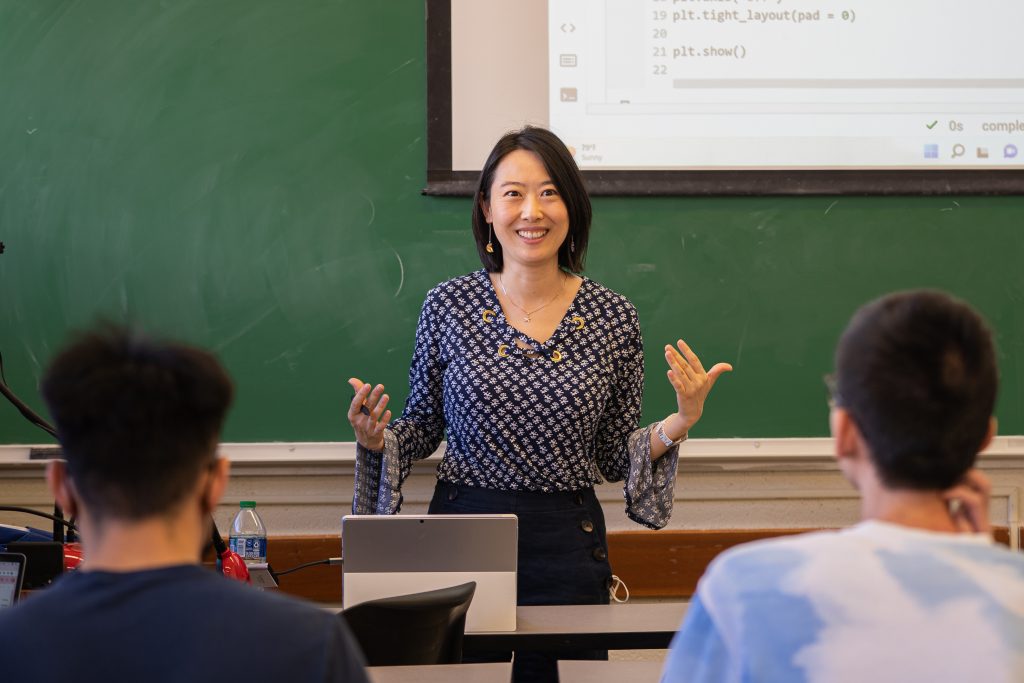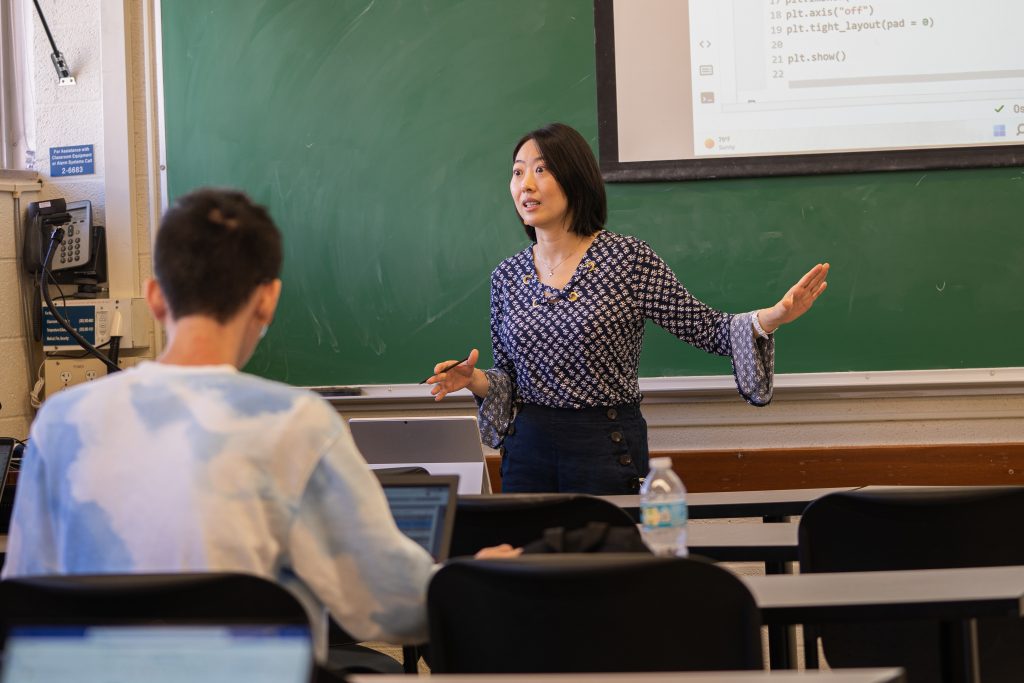Advertising Professor Explores Use of Emerging Technology to Understand Consumer Behavior
By Lenore Devore, B.S. Journalism 1984

Advertising Associate Professor in Artificial Intelligence Yang Feng has focused her research in two areas: using machine learning to analyze a large amount of data related to ad campaigns, and exploring the role of social media algorithms in shaping consumer opinions. The goal is to use technology to bring a new perspective and effect change.
She also wants to share her knowledge with students, an exciting prospect as she begins to make them comfortable with words like “machine learning” and “Python coding.”
“Five years ago, I started to learn machine learning. It’s a really great tool to analyze a large number of social media data related to ad campaigns,” Feng said. Comments left on social media posts generate discussions, and it can be important to understand consumer response. But it’s nearly impossible to sift through those comments without advanced tools. So she learned computer science and collaborated with an engineer to learn how to use machine learning in a systematic way.
“It’s not just simply applying machine learning from computer science to advertising,” she said. “You have to modify the procedure and introduce the use of qualitative analysis.”
Her research, which appeared in the prestigious Journal of Advertising four years ago, provided other scholars with six steps to follow. It did not include coding then, but in the last four years, she’s written more papers focusing on machine learning methodologies that have included using Python coding. “We have to bring change and a new perspective,” she said.
Feng also tries to bring a new perspective to examining consumer advertising. “When people examine consumer advertising interactions, they’re mostly focusing on the effectiveness of social media advertising – how consumers respond and how consumers interact with it.”
But they also should be reviewing consumers’ psychological factors and demographic backgrounds. “How do they interact with that? Source and consumer factors are two main streams of research in social media advertising.”
In addition to those two areas, researchers must bring in artificial intelligence (AI), she said.
Each social media platform uses a different algorithm, but they all result in a common ranking – pushing certain information to the top to shape responses. Her research on a controversial gender campaign revealed positive comments in a private survey but negative ones on the YouTube channel.
“Certain opinions were retained and never challenged, and other opinions were never registered,” she said. Comparing the social media data with survey data shows how the comment ranking algorithm (CRA) “may bias and shape people’s opinions.”

Feng is also studying trust in the CRA as part of the Consortium on Trust in Media and Technology. “CRA has established a certain kind of trust. But is this kind of trust healthy? What you’re seeing is these kinds of algorithms are using popularity metrics to shut people off, not encouraging them to speak freely.” She hopes to redesign the CRA from a social science perspective to “disrupt trust in algorithms so social media users may correctly estimate others’ opinions.”
She’s pleased that media like The Washington Post have taken an interest in technology and even interviewed her. And she’s glad many people are jumping to computational research. “Many researchers follow our way,” she said, and many are combining machine learning with traditional social science methods like surveys.
Researching the use of emerging technologies, including augmented reality (AR), virtual reality (VR) and 360-degree videos, to generate interactive advertising messages is another passion of Feng’s. Such technologies can enhance interactivity with social media advertising, she said.
But users must pay attention to their privacy, Feng said. She used Sephora as an example of using AR, which became more popular during the pandemic, when people did not want to shop in stores.
“Sephora had an app people could download to use a virtual mirror,” she said. “It was facial recognition and virtual reality. It captured your face so you could lay products in a virtual way so you can see how good products will look on your face and determine if you want to buy the products. It’s useful to facilitate online shopping.”
But once you turn on your camera, you give Sephora your biometric information, your face, which is personal to you, Feng said.
“So you’re not sure when they collect your personal information how they deal with it. Do they store it, share it with third-party advertisers or others? The practical concern is even though many apps like this have uploaded privacy guidelines, they are very long. How many people read them? Not many. They are hard to read, hard to find. They are set apart from the content of the app. They will not just pop up and remind you to read this.”
She’s conducting research to find what other ways – redesigning apps to provide more options inside the app, having an option to opt out, providing reminder messaging – work best to increase privacy protection behaviors.
She’s also interested in 360-degree videos, immersive experiences that can enhance positive attitudes. They are quite different from regular videos, which you watch passively, and require more effort from users, she said.
“With 360 degrees you have to use your mouse to control, to navigate. You have to do something. When people get lost, they cannot enjoy the brand message because their attention is drawn away. Not everyone can multitask,” Feng said.
The question is: How can you design the video to enhance brand promotion instead of distracting from the brand message? she said.

Feng left her job as an associate professor in advertising at San Diego State University to come to the University of Florida because of its focus on artificial intelligence. Many faculty at CJC want to add more AI elements to courses, something she wants to be involved in.
“The challenge is: When you mention AI to our students, because they don’t have a computational science background and they are not good at math, they are scared of the term. They are scared of machine learning. It’s very useful, but very difficult to learn. The goal is to help students who don’t have any computational science background to understand machine learning from conceptual and technical perspectives,” she said.
In the Fall 2022 semester, Feng taught Social Media Analytics and Strategy, which focused mostly on Python coding. “It’s a very useful programming language; very user-friendly compared to others. We are giving students this tool and hands-on experience to do coding, and while teaching that we’re introducing ideas related to algorithms and machine learning. My role is to calm students down and reassure them they have the capacity to learn this subject. I make those complex concepts easy to understand.”
After learning the skills, students work on real social media campaigns using Python to analyze data.
Feng teaches undergraduate and master’s students, all of whom have different skills and expectations. Undergrads want more hands-on skills while master’s students want to learn more about coding, theory and concepts.
“I’m always struggling to create a balance between the conceptual and the practical,” Feng said. “Ph.D. students reach out to me and express interest in my course; they want to learn machine learning. But if you don’t know Python, you probably cannot write code to do machine learning.”
Meeting the multiple needs of students and creating a solid foundation for them is “very challenging and exciting,” she said. “I feel like everybody has the potential to learn a complicated subject. But can a professor create the right approach?”
Posted: March 13, 2023
Category: AI at CJC News, College News, Profiles
Tagged as: AIatUF, Artificial Intelligence, Emerging Technology, Trust, Yang Feng


